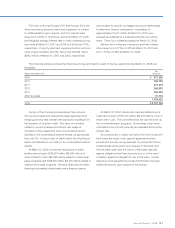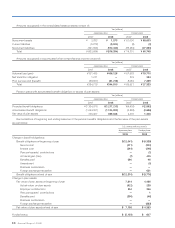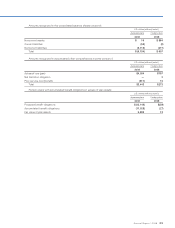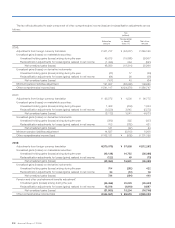Honda 2008 Annual Report Download - page 88
Download and view the complete annual report
Please find page 88 of the 2008 Honda annual report below. You can navigate through the pages in the report by either clicking on the pages listed below, or by using the keyword search tool below to find specific information within the annual report.
A n n u a l R e p o r t 2 0 0 8
8 6
The Company Law of Japan provides that earnings in an
amount equal to 10% of dividends of retained earnings shall
be appropriated as a capital surplus or a legal reserve on the
date of distribution of retained earnings until an aggregated
amount of capital surplus and a legal reserve equals 25% of
stated capital. Certain foreign subsidiaries are also required
to appropriate their earnings to legal reserves under the laws
of the respective countries.
Dividends and appropriations to the legal reserves
charged to retained earnings during the years in the three-
year period ended March 31, 2008 represent dividends
paid out during those years and the related appropriations
to the legal reserves. Dividends per share for each of the
years in the three-year period ended March 31, 2008 were
¥38.5, ¥77 and ¥84 ($0.84), respectively. The accompanying
consolidated financial statements do not include any provision
for the dividend of ¥22 ($0.22) per share aggregating ¥39,921
million ($398 million) proposed and resolved in the general
stockholders’ meeting held in June 2008.
The Company executed a two-for-one stock split for the
Company’s common stock effective July 1, 2006. Information
pertaining to dividends per share has been adjusted
retroactively for the year ended March 31, 2006 to reflect this
stock split.
12. Dividends and Legal Reserves
13. Pension and Other Postretirement Benefits
The Company and its subsidiaries have various pension
plans covering substantially all of their employees in Japan
and certain employees in foreign countries. Benefits under
the plans are primarily based on the combination of years of
service and compensation. The funding policy is to make
periodic contributions as required by applicable regulations.
Plan assets consist primarily of listed equity securities and
bonds.
Retirement benefits for directors, excluding certain
benefits, are provided in accordance with management
policy. There are occasions where officers other than
directors receive special lump-sum payments at retirement.
Such payments are charged to income as paid since
amounts vary with circumstances and it is impractical to
compute a liability for future payments.
In January 2003, the Emerging Issues Task Force (EITF)
reached a final consensus on Issue No. 03-2 “Accounting
for the Transfer to the Japanese Government of the
Substitutional Portion of Employee Pension Fund Liabilities”
(“EITF 03-2”). EITF 03-2 addresses accounting for a transfer
to the Japanese government of a substitutional portion of an
Employees’ Pension Fund (“EPF”) plan, which is a defined
benefit pension plan established under the Welfare Pension
Insurance Law. EITF 03-2 requires employers to account
for the separation process of the substitutional portion
from the entire EPF plan (which includes a corporation
portion) upon completion of the transfer to the government
of the substitutional portion of the benefit obligation and
related plan assets. The separation process is considered
the culmination of a series of steps in a single settlement
transaction. Under this approach, the difference between
the fair value of the obligation and the assets required to be
transferred to the government should be accounted for and
separately disclosed as a subsidy.
As stipulated in the Japanese Welfare Pension
Insurance Law, the “Honda Employees’ Pension Fund (a
confederated welfare pension fund, the “Fund”)”, of which
the Company and a part of its domestic subsidiaries and
affiliates accounted for under the equity method were
members, has obtained approval from the Japanese Minister
of Health, Labor and Welfare for exemption from benefits
obligations related to past employee service with respect to
the substitutional portion of the Fund on July 1, 2005 and
completed its transfer on March 9, 2006. Previously on
April 1, 2004, the Company received approval of exemption
from the obligation for benefits related to future employee
services with respect to the fund. As a result, the Company
recognized a gain of ¥228,681 million, which is the difference
between the settled accumulated benefit obligation and the
assets transferred to the government; a gain of ¥56,448
million for the derecognizing of previous accrued salary
progression; and settlement loss of ¥147,113 million for
the related unrecognized loss. Collectively, the Company
recognized a net gain of ¥138,016 million for the fiscal year
ended March 31, 2006.
The Company and its consolidated subsidiaries adopted
SFAS No. 158, “Employers’ Accounting for Defined Benefit
Pension and Other Postretirement Plans – an amendment of
FASB Statements No. 87, 88, 106, and 132(R)” on March 31,
2007, recognized its overfunded or underfunded status as
an asset or liability in its consolidated balance sheets.
























